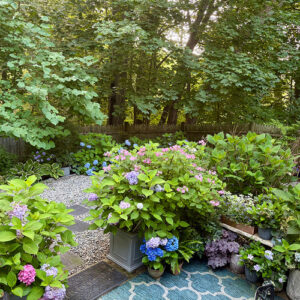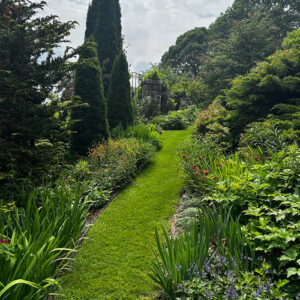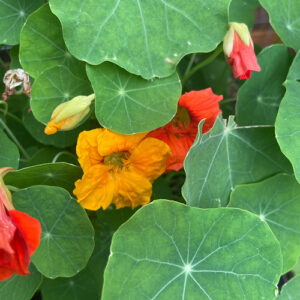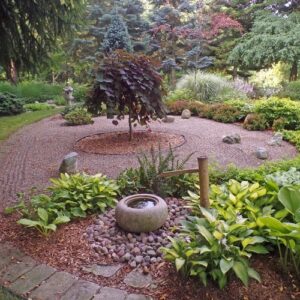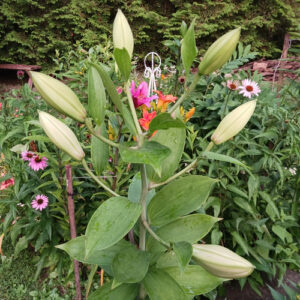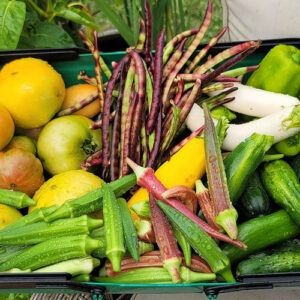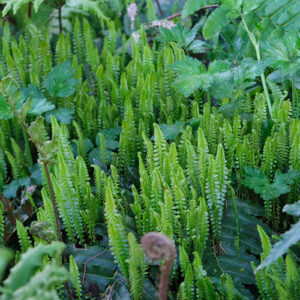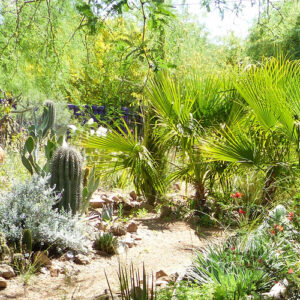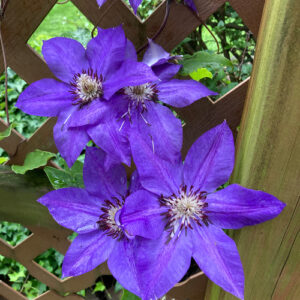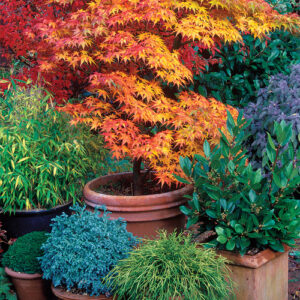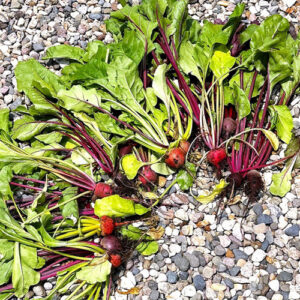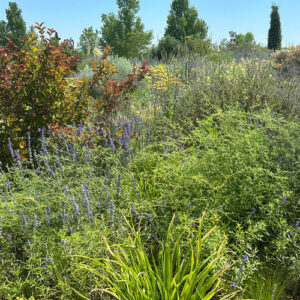February 1st, 2025 Posted In: Garden Style & Living
Recycled garden furniture, landscaping and planters can save you money.
And they always add character and individuality to your garden or backyard.
Plus it’s the most sustainable way of living. Even if your recycled garden isn’t cheaper than buying new, it’s still a better use of world resources.
Recycling can look contemporary – or it can create a rustic garden charm. And it’s at the heart of cottage garden style, now sometimes called ‘cottagecore’.

But finding the right recycled garden materials, furniture or pots isn’t always easy. By definition, these are not things you can just buy from a named retailer, who will deliver to your door in days.
I’ve spent a lifetime buying vintage and recycled. My mother had a stall on London’s famous Portobello Road.
And I’ve co-written a series of books on vintage and upcycling with stylist Liz Bauwens. She has a wonderful eye for spotting something special – see her online store, Otto Trading. So I’ve picked up lots of tips on finding and using fleamarket finds to create a beautiful but practical recycled garden.


Fleamarket Chic, one of the books Liz and I wrote together, has just been re-published. It covers vintage and recycled interiors in a range of styles from country and classic to contemporary. Find out where to shop, how to spot finds and whether to restore or not! You can buy Fleamarket Chic in the US and the UK here from Amazon or here from Bookshop.org.
Where can I find lovely vintage or recycled garden furniture and pots?
Probably the biggest complaint I hear about buying vintage and recycled goods is people saying ‘I can never find what I’m looking for.’
When you buy new, you go into a shop or online and search for a ‘garden bench’. You’ll see several garden benches in the store. And lots of garden benches will pop up online. There’s a good chance that you’ll see one you like. You order it and it’ll be delivered to your home.
But if you go into a salvage yard or charity/thrift shop looking for a garden bench, you’re unlikely to find it the first time you go. Even if you go to the big online auction houses, such as eBay and Gumtree, you won’t find your perfect garden bench just by looking up ‘bench’ a couple of times.


Get to know classic and vintage garden furniture styles. You’ll find out what you do and don’t like, and be able to spot bargains more quickly. Top is a metal bench at Doddington Place Gardens and above is a ‘Lutyens’ bench at Gravetye Manor Hotel.
When I searched online for ‘garden bench’, there were one or two beautiful vintage ones – but they were expensive. And the cheap ones were not especially nice.
However, if I were to repeat that search regularly, I’d have a better chance of finding what I’m looking for.
Buying vintage and recycled garden furniture and pots is a long game. All the top second-hand shoppers I know go into their local thrift or charity shops on a regular basis. They visit architectural salvage yards just to see what’s new.
So identify online auctions that deliver to your area. Set up an alert for the item you want. Start with Gumtree, eBay and PreLoved.
Then look for local architectural salvage yards or exchange sites.
Look up charities near you that sell second-hand furniture. These include Habitat ReStore, which operates in the US, Canada, the UK, Europe and Asia. And the Salvation Army operates in 133 countries and has some larger centres selling second-hand furniture. In Europe and the UK, there is Emmaus. Plus there are always local charities near you.
Don’t forget to factor in the costs of transporting items. You may not be able to fit anything large or heavy into an ordinary car.


And don’t forget to donate unwanted items to a charity if you’re clearing a house or garden. Some charities provide free pick-up if you are donating items.
The insider secrets on finding the best recycled garden items
The most important thing is to ‘get your eye in.’ That means getting to know what sort of things you like and what you could do with them.
Instead of looking for a particular item, such as a garden bench, start thinking about what you could turn something into.
And step one of ‘getting your eye in’ is to look at as many recycled, upcycled and vintage items as possible. The more you see, either in videos or posts like these or in real life, the more you’ll be able to see what you could do with them.


Four different ways of upcycling garden pots and planters. clockwise from top left: an old cooking pot re-used; food tins, painted and with the labels stripped off; old dustbins and garbage cans used as larger planters and equipment from a distillery re-purposed as garden planters. All have a rustic garden charm and would work in cottage gardens.
Professional thrifting tips
Visit the thrift shops, second-hand fairs and salvage yards as often as you can.
If it’s a fair or a market, get there early. Before it opens if you can.
At my mother’s Portobello Road second-hand stall, the professionals – the dealers – always arrived before the market was open. They helped her unpack! So they always got the best bargains.
Be systematic. Start at one end of the room, yard or row of stalls and go slowly along. Then move methodically back up the row on the other side. Don’t dart about.
Let people know you’re up for taking things they don’t want away. Sometimes you’ll see items left in the street or in front gardens. Always ask before taking anything – even if it has been discarded in a skip.
Once people know you are interested in second-hand, they’ll often get in touch. Kathy Pickering’s rustic cottage garden is full of ‘finds’ discarded from friends’ gardens.
And before you throw anything away, think about what it could be used for. Kathy has used the springs and frame of an old mattress as a trellis.


Kathy Pickering turned this sofa frame into a trellis for climbing plants (top) and designer Amanda Grimes designed this recycled show garden for RHS Hampton Court, using flagstones and scaffolding boards to make benches.
How to Landscape with Recycled Materials
We are all getting much more interested in using recycled landscape materials.
Several show gardens have recently featured crushed hardcore or rubble used as a mulch.


‘Chelsea Repurposed’ by Cityscapes (top) – a show garden using a crushed concrete and sand mulch. Above is a mulch made from bricks, stones and rubble picked out of the earth from elsewhere in the Walworth Garden. See here for more about the Walworth Garden’s recycled landscaping.
If you have a garden in a town or a new-build development, you’ll probably have lots of bits of broken concrete, broken bricks, pebbles or rocks in your earth. You’ll have to pick them out before you can clear it for planting. Instead of taking them to landfills, you can use them as mulch.
You can also use this kind of mulch as a basis for dry planting or a gravel garden.
At Great Comp Garden in Kent, the owner had to dig lots of ragstone out of the ground to clear it for borders. He found so much that he decided to build ‘ruins’ with it in the garden.
He also mounded the ground in one place up to build a ‘ruin’ on top of it. He used discarded washing machines and pieces of old agricultural equipment to get the volume of the mound before covering it all with soil. See more about how he did it in Garden Ruins & Follies.
Make the most of what you’ve already got
There’s an increasing interest in making the most of what you’ve got. If your yard is completely covered in concrete or pavers, then take some of it up to allow more planting. You can make it look more attractive by setting a pattern of brick or stone into it rather than replacing the whole area.


Top: Leftover brick, stone and pebbles used to make a pattern. Above: this garden owner filled cracks in the concrete paving with patchwork patterns of tile, brick, stone and pebble rather than replacing the concrete completely.
You may also be able to re-use landscape materials discarded from another garden. Tell your landscapers you’d like to use recycled materials if you can. They will usually know of a local depot or they may be able to sell or give you materials from another job.
What are the best recycled materials for a garden?
The best recycled materials for a garden will be anything that is already in your backyard or which can be transported easily from nearby.
But if you don’t have any second-hand materials nearby, then there is no single ‘best material.’


Recycled wood, stone and brick mixed together. Old beams, pallet wood, railway sleepers and scaffolding boards are combined with different bricks in this show garden by Simon Cowell. The recycled materials give it a lovely textured feel.
If your aim is to be more eco-friendly, then Oli Haden, head gardener and CEO of the Walworth Garden in London, says that there are two important questions to ask. This applies to both new and recycled materials.
The first question is ‘how are you going to fix it into the garden?’ If you’re going to use concrete, then your recycled garden will be less sustainable and eco-friendly.
Secondly, how long will it last? Materials that need replacing quickly are expensive – because it costs to replace them. The two materials which will need replacing soonest are artificial grass and softwood decking, so if you’re planning in staying somewhere for a long time, avoid those two.
Oli says that recycled stone is the best material because it lasts for centuries and doesn’t have to be set into concrete. However, Oli says you will have to fit the pavers together as closely as possible and add a boundary to hold them in place. This could be wood sleepers or a steel band.
Read more about eco-friendly landscaping here.
Recycled garden art and decor
You can re-purpose so many things as garden art and decor. Some of them may not last long, but if they were going to be thrown away anyway, you’re giving them another use before you eventually discard them.
The garden shows in the UK now feature an increasing number of recycled garden ideas. See recycled RHS Chelsea and some of the show gardens in this RHS Hampton Court round-up.


Plumbing pipes and tanks re-purposed for the garden. Top: garden designer Mike Long’s show garden featuring re-purposed concrete water ducts (the wide circular pipe), copper piping and taps used in a water feature. Above: author Naomi Slade’s show garden featuring old water tanks re-used as ponds/water features. Both are such great examples of ‘from trash to treasure!’


Top: broken terracotta pots fitted together and planted up with succulents. (These are called fairy gardens in some places.) Succulents have shallow roots so are happier than most plants in this kind of arrangement. Above: a rusted petrol (gas) pump on a show garden by Gardena. Almost anything can be re-used or recycled if you like how it looks!


Top: Broken china and shells collected from the beach used as mosaic garden decor. Above: industrial equipment re-purposed as a moongate arbour seat in Pip Probert’s Viewers Garden at BBC Gardeners World Live.
Recycled garden border edging
Recycled garden border edging ideas include using strips of old corrugated iron, recycled bricks and scaffolding boards.
You can also use wicker for a rustic look, but be aware that it won’t last long.


Top: Garden border edging using painted car tyres in Spain. Above: wine bottle edging in Jo Rutherford’s garden on a budget.
In the photo above, gardener Jo Rutherford collected wine bottles. She sank them into the earth so that they were approximately half buried. Many people have suggested that these could freeze and break in winter. So far they haven’t, but Jo is based in Whitstable, a coastal town with mild winters.
Car tyre edging also has its issues. Car tyres slowly leach chemicals over a number of years. They’re not advised for vegetable growing, although the process is very slow.
If you’re using wooden sleepers or scaffolding boards, try to avoid those that are treated with tar or creosote. They’ll look darker than untreated wood. Tar and creosote also leach chemicals into the soil, although if they are old, it may already have worn off.
Some sleepers and scaffolding boards are tanalised, which is considered safe for use in gardens.
From trash to treasure – pots and planters
Plants will grow in any kind of container.


Plants will grow in anything – the top shows two pots hanging from some old plumbing pipes and the photo above is a rusted dustpan turned upside down for cyclamen.
So there are only two things you need to know about re-purposing things as pots and planters.
Firstly, you must have drainage. If water sits at the bottom of a pot, the roots of the plant will rot. You can drill holes in wood and metal, but china and stone are more problematic.
Secondly, most plants need room for their roots to grow. The size of the pot you need depends on the plant – for example, succulents can grow in very shallow containers.
However, most plants need a pot that’s at least roughly half the height of the fully grown plant. In fact, the upturned rusty dustpan above fits both these requirements!
In terms of width, go for a pot that is just an inch or so wider than the root ball. If the plant is still young, you may have to re-pot it several times as it grows.
Make sure your re-purposed pots will survive your winters
And in terms of outdoor planters, you need to choose a material that will survive your winters.


Top: This chest of drawers is planted up as a fun item by garden designer Mark Lane. Above: old olive tins used as planters – note how the whole plant is just a bit bigger than the size of the tin.
Beyond that, you can use almost anything for a planter. Garden designer and BBC Gardeners World presenter Frances Tophill says she has used an old washing machine drum in the past.
People have used drawers (although wood will rot quickly), agricultural troughs, old laundry bins and food tins, watering cans that no longer hold water, rusted wheelbarrows and all kinds of industrial equipment such as oak casks from distilleries to water tanks.
From office to backyard? Re-purposing indoor furniture
When you’re looking for second-hand furniture, don’t forget to check sales of old office furniture or shop-fittings. Very often these will be made of durable materials that will last outside, such as metal.


Look at shop and office equipment as well as indoor furniture, provided that it’s made of waterproof material. Top: a widely available style of dining or cafe chair in metal, so it can used outside. Above: The table and mannequin were both bought from a shop that was shutting down.


Top: ‘Chelsea Re-purposed’ show garden by Cityscape – all the materials and furniture in the top photo are second hand. Above: gardener Jo Rutherford’s wooden chairs. A client was throwing the chairs out and gave them to her. Jo revived them with a coat of paint.
Composting – the ultimate recycling
The more you can recycle and compost the waste material from your kitchen and garden, the better. You’ll be returning nutrients to the earth and saving on trips to the dump. And you will save some – although not all – of the costs of buying new mulch.
However, you do need some space to compost unless you are using, for example, a Hotbin, which breaks down waste material fast.
The essential thing to know is that there is fast compost and there is easy compost. Unless you are using something like a Hotbin, there is no fast, easy compost.
With easy compost you need at least three bin areas. Add vegetable and fruit kitchen scraps, but not meat, fish or cooked food. Add clippings and pruning from the garden. If you cut them up, they will biodegrade faster.
With fast compost, you may need more bin areas. You need to pay attention to the mix of ‘brown’ and ‘green’ elements. You will turn the compost at least once a week. It’s not difficult but it does need management.
Fast compost breaks down over a few months, so it should give you more compost. Easy compost can take a year to eighteen months. I do easy compost (see here) and speed it up with a compost accelerator such as Garotta or Envii. (note, these are affiliate links, see disclosure)
Compost breaks down, so a huge pile of garden clippings turns into quite a small layer of mulch. This means that very few gardens ever make enough compost to completely cover their garden beds. But at least you’ll save some money on it!
Pin to remember recycled garden ideas
And do join us. Sign up here for a free weekly email with more gardening tips, ideas and inspiration.



